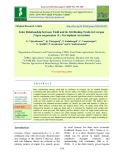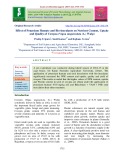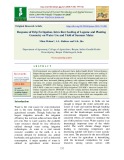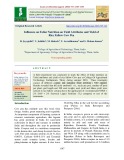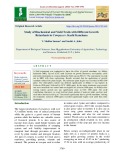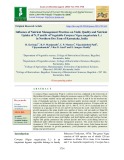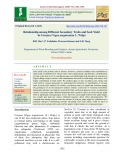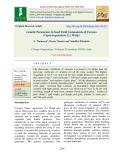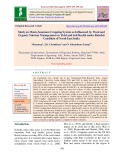
Seed yield in cowpea
-
The experiment evaluation and characterization of cowpea (Vigna unguiculata L.Walp) genotypes for growth, yield and quality parameters in Prayagraj agro-climatic region was conducted at Field Experimental centre as well as in post graduate Seed Testing Laboratory, Department of Genetics and Plant Breeding, Sam Higginbottom University of Agriculture, Technology and Sciences, Prayagraj (U.P.).
 11p
11p  chauchaungayxua10
chauchaungayxua10
 19-03-2021
19-03-2021
 15
15
 2
2
 Download
Download
-
Field experiment was conducted to find out the influence of foliar nutrition on growth and seed yield of pulse crop during rabi 2013-14. The experiment was laid out in split plot design and replicated thrice. The pulse crop viz., blackgram, greengram, cowpea and horse gram were tried as treatments under main plot. Foliar nutrient sprays viz., 2 % DAP, 1 % KCL, 1% boron, 1 % MgSO4, 1 % ZnSO4 and without foliar spray were fitted under sub plot. Foliar spray treatment with the aqueous solution of nutrients was done on 30 and 45 DAS of pulse crop.
 6p
6p  trinhthamhodang1218
trinhthamhodang1218
 26-02-2021
26-02-2021
 19
19
 2
2
 Download
Download
-
The present investigations were conducted in the Department of Food Science and Technology, Dr YS Parmar University of Horticulture and Forestry, Nauni, Solan (HP) during the year 2013-2015.
 8p
8p  gaocaolon9
gaocaolon9
 22-12-2020
22-12-2020
 9
9
 1
1
 Download
Download
-
Thirty genotypes of cowpea were grown during the rainy season of 2014-2015 to study the interrelationship among quantitative traits. The experiment was laid out in a randomized complete block design (RCBD) with three replications at the Research Field of the Department of Plant Breeding and Genetics, MPUAT University, Rajasthan.
 9p
9p  angicungduoc8
angicungduoc8
 07-11-2020
07-11-2020
 13
13
 1
1
 Download
Download
-
Generation mean analysis study in cowpea was undertaken to estimate the gene action operating in the inheritance of yield and its components. Six basic generations viz., P1, P2, F1, F2, BC1 and BC2 of five crosses, namely Pant lobia-1 x BRDCP-11 (cross I), Pant lobia-2 x GC-3 (cross II), Waghi local x W-203-1 (cross III), KM-5 x GC-3 (cross IV) and GC-3 x CDP-107 (cross V) were studied. Scaling test was applied to test the adequacy of additive-dominance model for the traits under investigation.
 10p
10p  chauchaungayxua8
chauchaungayxua8
 03-10-2020
03-10-2020
 15
15
 2
2
 Download
Download
-
The present investigation was conducted at College Farm, N. M. College of Agriculture, Navsari Agricultural University, Navsari during kharif - 2016 with a view to study the heterosis and inbreeding depression in five crosses (each having P1, P2, F1, F2, BC1 and BC2 generations) of cow pea through a compact family block design with three replications.
 9p
9p  trinhthamhodang1215
trinhthamhodang1215
 23-09-2020
23-09-2020
 9
9
 2
2
 Download
Download
-
The present experiment was conducted using 60 genotypes of cowpea to study their correlation and path analysis during kharif-2015. It can be concluded from these experiment findings that main yield contributing traits are biological yield per plant, number of pods per plant, number of flowers per plant, test weight, number of pods per cluster, pod length, number of seeds per pod, number of clusters per plant, harvest index and plant height due to their direct high positive association with seed yield.
 10p
10p  trinhthamhodang1215
trinhthamhodang1215
 23-09-2020
23-09-2020
 19
19
 1
1
 Download
Download
-
d of irrigation commonly followed by the farmers in this region is expensive and inefficient since it causes high water and nutrients losses in deep percolation. Keeping this in view, the present study was contemplated with the objective of examining the effect of irrigation scheduling on growth, yield and yield variables and water use efficiency of cowpea.
 12p
12p  caygaocaolon7
caygaocaolon7
 18-09-2020
18-09-2020
 24
24
 0
0
 Download
Download
-
Inter relationship among yield and its attributes in cowpea can be studied through correlation and path analysis. In the current study, 102 Indian cowpea genotypes were evaluated based on twelve quantitative characters to study the association between yield and its contributing traits. Single plant yield showed significant positive correlation with traits viz., number of clusters per plant, number of pods per plant, pod length, number of seeds per pod, number of pods per cluster and hundred seed weight.
 7p
7p  caygaocaolon6
caygaocaolon6
 30-07-2020
30-07-2020
 19
19
 1
1
 Download
Download
-
India is the largest producer and consumer of the pulses in world. There is a huge shortage of pulses in the country to meet out the domestic demand especially of vegetarian population. The low production and productivity of pulses under Indian condition is mainly due to several biotic and abiotic constraints. In general, the pulses crops are more susceptible to the stresses including weeds as compare to the cereals and oilseeds. It was widely reported that yield losses due to weeds especially in the pulses are more than the loss caused either by insect-pest or diseases.
 13p
13p  nguaconbaynhay6
nguaconbaynhay6
 24-06-2020
24-06-2020
 15
15
 0
0
 Download
Download
-
A pot experiment was conducted during kharif season of 2014-15 at the cage house, Sri Karan Narendra Agriculture University, Jobner. The application of potassium humate and seed inoculation with bio-inoculants significantly increased the NPK content and uptake, quality and yield of cowpea. The results revealed that the higher values of NPK content, uptake and Protein content in seed of cowpea are obtain under the application of potassium humate @10 mg/kg soil and Rhizobium + VAM + PSB seed inoculation than other treatment.
 7p
7p  nguaconbaynhay6
nguaconbaynhay6
 24-06-2020
24-06-2020
 15
15
 0
0
 Download
Download
-
Field experiment was conducted on Research farm, Indira Gandhi Krishi Vishvavidyalaya Raipur during summer 2016 to study the response of drip fertigation intra row seeding of legume and planting geometry on soil health productivity and net return of summer maize. The experiment was laid in strip plot design with six vertical drip fertigation and intra row cowpea and three horizontal planting geometry with eighteen treatments.
 6p
6p  nguathienthan5
nguathienthan5
 04-06-2020
04-06-2020
 12
12
 0
0
 Download
Download
-
A field experiment was conducted to study the effect of foliar nutrition on Yield attributes and yield of rice fallow Cow pea at College Of Agricultural Technology, Kullapuram, Theni, during summer 2018. These treatments consist of different organic and inorganic foliar nutrition’s were applied. Results revealed that the yield attributes viz.
 5p
5p  nguaconbaynhay5
nguaconbaynhay5
 16-05-2020
16-05-2020
 18
18
 1
1
 Download
Download
-
A field experiment was conducted to know the effect of growth retardants viz, Maliec hydrazide (MH), Cycocil (CCC) and Lichocin on growth characters, seed quality, yield and yield components in cowpea during the Rabi season 2016-17. The experiment was laid out in RBD with three replications. Results revealed that the application of growth retardant reduced the plant height. The minimum plant height was recorded in MH (500 ppm).
 5p
5p  kethamoi4
kethamoi4
 16-04-2020
16-04-2020
 13
13
 1
1
 Download
Download
-
A cowpea (Vigna unguiculata Walp L.) cultivar trail was conducted at the University of Horticultural Sciences, Bagalkot during the monsoon season in 2016. The objective of this trail is to evaluate suitable variety and optimum dose of N, P, and K for the northern dry zone of Karnataka and also to evaluate nutrition quality (protein content) of vegetable cowpea as influenced by the different nutrient management practices. Cowpea seeds are sown on different treatment beds like 125 %, 100 %, 75 %, 50 % recommend dose of fertilizers at a spacing of 45 cm row and 20 cm between the seeds.
 15p
15p  kethamoi4
kethamoi4
 16-04-2020
16-04-2020
 19
19
 1
1
 Download
Download
-
Seed yield is the primary trait of interest, however, several secondary traits contributes in final yields. Contribution of various traits varies significantly, and therefore, identification of traits with their level of contribution into seed yield might help breeders in selection of high yielding cowpea varieties with simultaneous selection for seed along with trait(s) with higher contribution in final yields. We studied range of key secondary traits along with seed yield in cowpea genotypes to understand the hierarchy of contribution of various traits in seed yield.
 15p
15p  kethamoi4
kethamoi4
 16-04-2020
16-04-2020
 7
7
 1
1
 Download
Download
-
The phenotypic coefficient of variation was found to be higher than the genotypic coefficient of variation for all the traits studied. The highest magnitude of GCV was observed for pod weight followed by number of pod clusters plant-1 , seed yield plant-1 , 100 seed weight, pod length, number of pods cluster-1 and number of pods plant-1 . All the characters considered except number of primary branches plant-1 , number of pods plant-1 and seed yield plant-1 recorded high estimates of heritability.
 7p
7p  quenchua4
quenchua4
 16-04-2020
16-04-2020
 11
11
 1
1
 Download
Download
-
Random Amplified Polymorphic DNA (RAPD) Markers were use to determined the genetic variability of eight divers cowpea (Vigna unguiculata L. walp) genotypes from different eco-geographical regions of India. Total primers 40 out of there 35 could be generated DNA fragment were 1479 but were as 1159 showed polymorphic pattern with 78.34 per cent. The polymorphism was scored and used in band sharing analysis to identify genetic relationship between the genotypes.
 8p
8p  caygaocaolon3
caygaocaolon3
 09-03-2020
09-03-2020
 29
29
 1
1
 Download
Download
-
An experiment was carried out at the Instructional-Cum-Research farm, Assam Agricultural University, Jorhat during 2013 and 2014 to study the effect of fertility management (F0 - control, F1 - 2.5 t/ha enriched compost, F2 - 5.0 t/ha enriched compost) and weed management (W0-weedy check, W1- hand hoeing and earthing up at 20 and 50 DAS, W2-in situ cowpea mulching upto 50 DAS,W3- in situ blackgram mulching upto 50 DAS) in maize and also to study the carry-over effects of these treatments on the succeeding sesamum crop in a split-plot design with 3 replications.
 17p
17p  caygaocaolon3
caygaocaolon3
 27-02-2020
27-02-2020
 23
23
 1
1
 Download
Download
-
An experiment was conducted to estimate genetic variability, heritability and genetic advance expressed as per cent of mean in F2 population of two crosses viz., DCS-47-1 × PL-1 and DCS-47-1 × PGCP-12 in cowpea. Analysis of variance revealed significant differences among the segregants tested for all the sixteen characters. High PCV and GVC were observed for number of secondary branches per plant, leaf to stem ratio, number of pods per plant, green fodder yield per plant, green fodder yield per metre row length and stover yield per plant in both the populations.
 9p
9p  cothumenhmong3
cothumenhmong3
 22-02-2020
22-02-2020
 19
19
 0
0
 Download
Download
CHỦ ĐỀ BẠN MUỐN TÌM









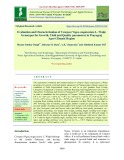
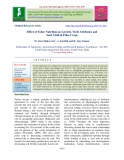
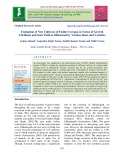
![Character association for seed yield and its components in cowpea [Vigna unguiculata (L.)Walp] Character association for seed yield and its components in cowpea [Vigna unguiculata (L.)Walp]](https://tailieu.vn/image/document/thumbnail/2020/20201107/angicungduoc8/135x160/541604712677.jpg)
![Generation mean analysis for yield and yield components in cowpea [Vigna unguiculata (L.) Walp.] Generation mean analysis for yield and yield components in cowpea [Vigna unguiculata (L.) Walp.]](https://tailieu.vn/image/document/thumbnail/2020/20201003/chauchaungayxua8/135x160/5641601687566.jpg)
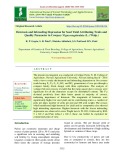
![Character association and path analysis in cowpea [Vigna unguiculata (L.) Walp] germplasm line Character association and path analysis in cowpea [Vigna unguiculata (L.) Walp] germplasm line](https://tailieu.vn/image/document/thumbnail/2020/20200923/trinhthamhodang1215/135x160/5311600825449.jpg)

